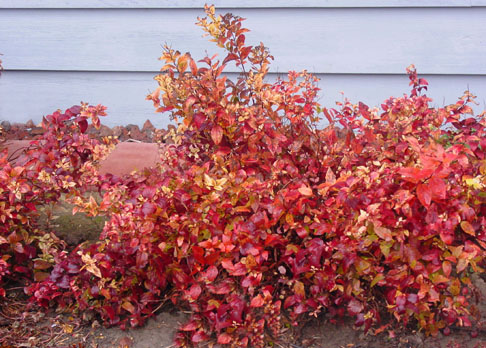A question came in from Sandy Heikkila located in Ontonagon, Upper Pennisula Michigan. She wanted to know when to prune her spirea and barberry shrubs.
Answer: The best time for cutting back both shrubs is early spring before new growth begins. According to the University of Minnesota, spring pruning is standard for any shrub grown primarily for its foliage.
Pruning Spirea: You could cut them back at any time of the season if size or shape is a consideration but the most common method is to prune them back to about 6 inches in spring. Also at that time remove the oldest and thickest stems to re-invigorate your spirea. In a few months the shrub will be the same size as last year.
If you want your spirea shrubs to rebloom, you could shear them right after they bloom and you should get a more flowers in fall. Basically, cut off all of the spent blooms and prune back to a set of leaves, so there remains a leafy outline to the plant.
My first experience with pruning was when my Goldflame spirea hedge got so leggy and unattractive that I was ready to rip it out and plant something else. My sister Milly told me to try pruning the plants severely in spring before they send out any leaves. When I followed her instructions the next spring, my spirea shrubs looked for all the world like I had killed them. But a few weeks later they were covered with new shoots and looked better than they had for years. I do this now every 2-3 years.
Pruning Barberry: Of all the varieties of barberry bush, Japanese barberry is the most common. Popular for its scarlet fall color and smaller size, this shrub produces red berries that last well into winter. Japanese barberry makes a pleasant alternative to evergreens as a hedge or border planting.
The evergreen forms of barberry (the ones that don’t lose their leaves) need to be pruned immediately after they flower. And if they’re to be cut back, save that for late winter or early spring. Deciduous barberry need to be trimmed in late summer.
Pruning basics for shaping your shrubs from the research:
- Sterilize the blades of pruning equipment before use. Dip them in boiling water for 30 seconds to remove any bacteria or fungus.
- Put on gloves and wear a long-sleeved shirt or jacket to protect your skin. Examine the shape of the shrub and decide what you’d like it to be.
- Look for deadwood in the interior of the shrub. Cut it out with pruning shears. Look for wilting or diseased branches and remove them. Trim any suckers from the base of the plant.
- Remove larger branches near the trunk by angling the blades of your pruning shears at 45 degrees, down and away from the trunk to avoid injuring the trunk’s bark.
- Lightly manicure the top and sides of your bushes with a hedge clippers. Clip the sides from the top down at a 15-degree angle so that the shrub is slightly wider at the bottom than it is at the top. This will allow sun to reach all parts of the shrub.





Great! Good article. I did this to my creeping cotoneaster that had so much dead wood that I thought I had lost it. I cut it way back in spring and I couldn’t believe how it grew back and looks so healthy now.
An outstanding share! I’ve just forwarded this onto a co-worker who has been doing a little research
on this. And he in fact ordered me breakfast because I stumbled upon it for him…
lol. So let me reword this…. Thanks for the meal!! But yeah, thanks
for spending the time to talk about this issue here on your
web site.